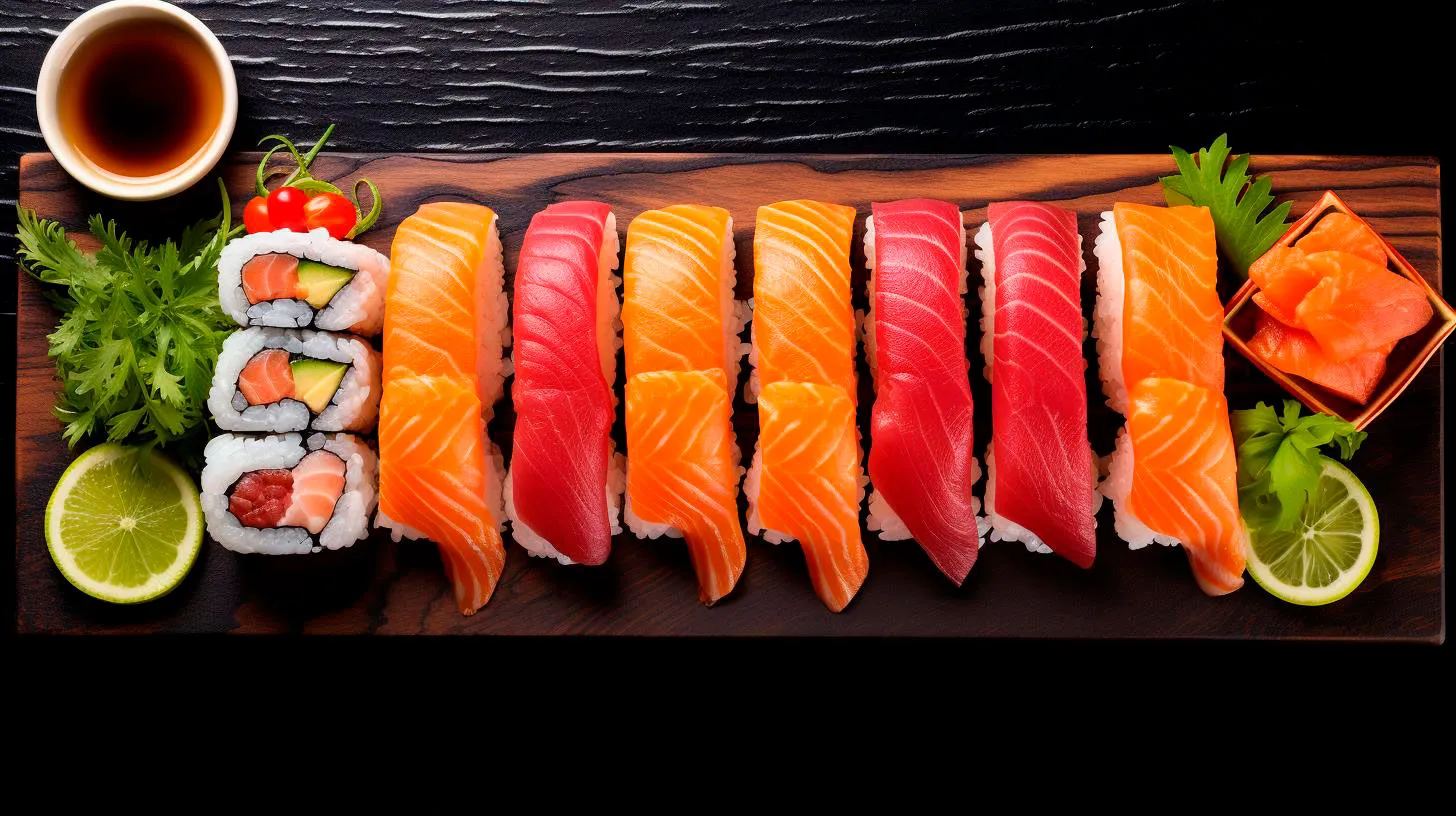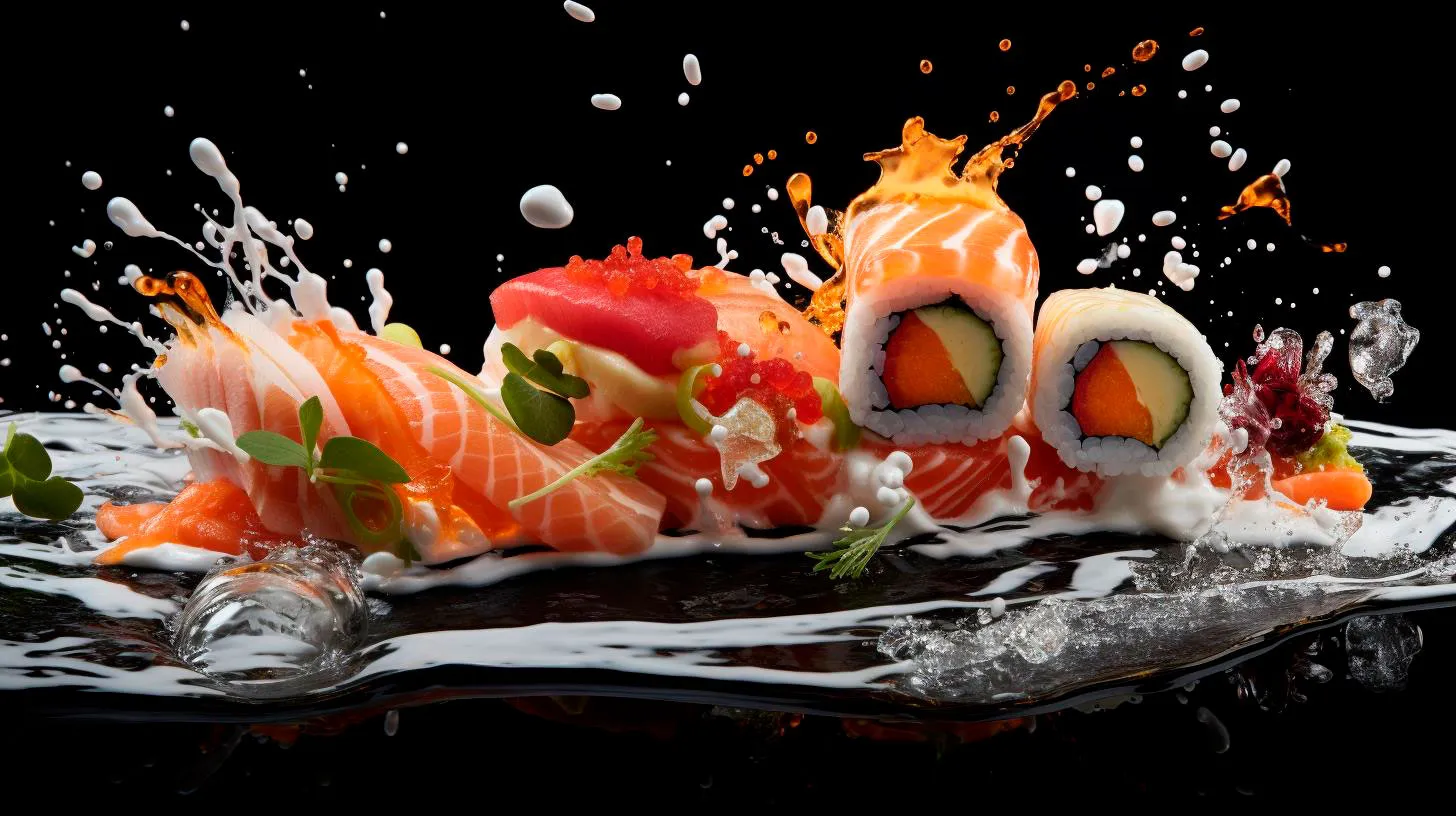Navigating Sushi Menus with Food Allergies
In this article, we will explore some essential tips and considerations to help sushi lovers with food allergies make informed choices and enjoy this delectable dish without worries.
The Importance of Food Allergy Awareness
Food allergies are a serious concern that affects millions of people around the world. Allergies occur when the immune system overreacts to harmless substances present in certain foods. Common food allergens include shellfish, fish, soy, wheat, dairy, and sesame seeds, all of which can be found in sushi. Therefore, it is crucial for individuals with food allergies to stay vigilant and informed about the ingredients used in sushi preparations.
When dining out, it is essential to communicate your food allergies to the restaurant staff. While some sushi establishments may have allergen-specific menus or knowledgeable staff, others may not be aware of the potential risks involved. By informing the staff about your food allergies, they can take necessary precautions and guide you towards safe options on the menu.
Tips for Navigating Sushi Menus with Food Allergies
Here are some valuable tips that can help you navigate sushi menus safely if you have food allergies:
- Research and choose allergy-friendly sushi restaurants: Before dining out, research sushi restaurants that prioritize food allergy safety. Look for establishments that have positive reviews regarding their commitment to accommodating food allergies.
- Communicate your allergies: Inform your server or chef about your food allergies. Clearly explain the specific ingredients you need to avoid. A good sushi chef will make necessary adjustments to ensure your safety.
- Be cautious of cross-contamination: Cross-contamination can occur when utensils, cutting boards, or surfaces used for allergen-containing dishes come into contact with allergen-free dishes. Ensure that the chef uses separate tools and prepares your sushi in a clean and safe environment.
- Explore allergy-friendly options: Sushi menus often offer a wide variety of options. Look for dishes that are naturally free of the allergens you need to avoid. For example, sashimi (fresh slices of fish), cucumber rolls, or avocado rolls can be safe choices for those with shellfish, soy, or wheat allergies, respectively.
- Read menu descriptions and ask questions: Carefully read through menu descriptions to identify potential allergens. Don’t hesitate to ask the staff about specific ingredients or preparation techniques if you have any doubts or concerns.
- Bring allergy alert cards: Consider carrying allergy alert cards that list your food allergies and dietary restrictions. These cards can be helpful in clearly communicating your needs to the staff, especially if there are language barriers.
- Avoid sauces and dressings: Many sushi dishes are accompanied by sauces and dressings that may contain allergens. To stay safe, either request for allergen-free sauces or avoid them altogether.
The Future of Allergy-friendly Sushi
The food industry is becoming increasingly aware of the importance of catering to individuals with food allergies. According to a market research report by Global Market Insights, the global food allergy diagnostic market is projected to exceed $8 billion by 2027, highlighting the growing demand for allergy-friendly dining options.
As more people become conscious of food allergies, sushi restaurants are adapting to provide safer dining experiences. Some establishments are offering dedicated allergy-friendly menus, while others are training their staff to handle food allergies with utmost care. Allergic Living reports that renowned sushi restaurants are undergoing allergen-aware training programs to ensure the safety of their customers.
Key Takeaways
Enjoying sushi should not be a daunting experience for individuals with food allergies. By following these tips and being proactive, you can navigate sushi menus with confidence:
- Research and choose sushi restaurants that prioritize food allergy safety
- Communicate your food allergies clearly to the staff
- Be aware of potential cross-contamination risks
- Explore allergy-friendly options on the menu
- Read menu descriptions and ask questions to ensure ingredient safety
- Consider carrying allergy alert cards for effective communication
- Avoid sauces and dressings that may contain allergens
With the increasing awareness about food allergies and the efforts made by the food industry, sushi lovers with dietary restrictions can now savor their favorite cuisine without compromising their health and safety. Remember to stay informed, communicate your needs, and enjoy the delightful flavors of sushi with peace of mind!
Exploring Allergy-Friendly Sushi Alternatives
In this blog post, we will explore some allergy-friendly sushi alternatives that you can try.
The Rise of Allergy-Friendly Sushi Alternatives
Sushi has gained immense popularity worldwide, becoming a go-to option for food enthusiasts. However, it often contains ingredients that can trigger allergies, such as fish, shellfish, soy sauce, and gluten. As food allergies become more prevalent, the demand for allergy-friendly sushi alternatives has also increased. Many innovative chefs and restaurants have risen to the challenge, creating delicious alternatives that cater to individuals with various allergies.
Exploring Allergy-Friendly Sushi Alternatives
1. Vegan Sushi:
Vegan sushi is an excellent option for those with dairy, egg, or fish allergies. It replaces traditional sushi ingredients with plant-based alternatives. Instead of fish, vegan sushi offers creative fillings such as avocado, cucumber, carrot, and tofu. These alternatives not only provide a satisfying taste but also contribute to a healthier and eco-friendly lifestyle. Vegan sushi has seen a surge in popularity, and many restaurants now offer a range of vegan sushi options.
2. Gluten-Free Sushi:
For individuals with gluten intolerance or celiac disease, traditional sushi can pose a challenge due to soy sauce or the presence of gluten in imitation crab. Gluten-free sushi addresses this issue by using gluten-free soy sauce or tamari and omitting gluten-containing ingredients. You can enjoy a variety of sushi rolls made with alternative grains like quinoa or rice paper wrappers, ensuring a safe and delicious dining experience.
3. Allergen-Free Sushi Bars:
Some sushi bars specialize in allergy-friendly sushi, catering to customers with specific dietary restrictions. These establishments take extra precautions to avoid cross-contamination and ensure the ingredients used are free from common allergens. By visiting an allergen-free sushi bar, you can enjoy a worry-free dining experience and indulge in sushi even with multiple allergies.
4. Sushi Made with Alternative Fish:
For seafood allergies, there are sushi alternatives available that replace fish with other proteins. These may include options like smoked salmon made from carrots, faux tuna created using tomatoes or watermelon, or even “crab” rolls made with shredded jackfruit. These alternatives replicate the textures and flavors of traditional sushi, making them a suitable option for seafood allergy sufferers.
The Benefits of Allergy-Friendly Sushi Alternatives
Exploring allergy-friendly sushi alternatives not only allows individuals with allergies to enjoy this beloved cuisine but also offers several benefits:
- Healthier Options: Allergy-friendly sushi alternatives often incorporate fresh vegetables, providing a nutritious and well-balanced meal.
- Diverse Flavor Profiles: These alternatives introduce unique combinations of ingredients, expanding the range of flavors available in sushi.
- Enhanced Dining Experience: Allergy-friendly sushi options ensure that everyone, regardless of dietary concerns, can participate in sushi dining experiences.
- Increased Accessibility: With the rise of allergy-friendly sushi options, individuals with allergies now have more choices when it comes to enjoying this Japanese delicacy.
Conclusion
Don’t let allergies prevent you from experiencing the joy of sushi. Explore the wide range of allergy-friendly sushi alternatives available that cater to different dietary needs. Whether vegan, gluten-free, or allergen-free options, you can indulge in the flavors and textures of sushi without compromising your health. Embrace these alternatives, expand your culinary horizons, and dive into the world of allergy-friendly sushi!
Satisfying Sushi Cravings while Adhering to Allergy Guidelines
Understanding Common Allergens in Sushi
Sushi is primarily made of rice, seaweed, and various fillings, such as fresh fish, vegetables, and sauces. While these ingredients are generally safe for most people, there are a few allergens commonly found in sushi that individuals should be cautious about:
- Seafood allergies: Raw fish and shellfish, like shrimp, crab, and squid, are frequent sushi ingredients that can trigger allergic reactions.
- Soy allergies: Soy sauce, a staple condiment in sushi, contains soybeans and gluten, making it off-limits for individuals with soy allergies or those following a gluten-free diet.
- Sesame allergies: Many sushi rolls are garnished with sesame seeds or include sesame oil, which can cause allergic reactions in those with sesame allergies.
- Gluten allergies: Some sauces, like eel sauce or tempura batter, may contain gluten, making them unsuitable for individuals with gluten sensitivities.
- Dairy allergies: Certain sushi rolls may include cream cheese or other dairy-based ingredients, posing a risk for people with lactose intolerance or dairy allergies.
Options for Allergy-Friendly Sushi
If you have food allergies but still want to enjoy sushi, fear not! Many sushi restaurants nowadays provide options to accommodate various dietary restrictions. Here are some allergy-friendly sushi choices to consider:
- Vegetable rolls: Opt for sushi rolls filled with a colorful assortment of fresh vegetables, avocado, or tofu. These rolls are usually free from common allergens and make a refreshing and nutritious choice.
- Sashimi: Sashimi, thinly sliced raw fish or seafood served on its own, is an excellent choice for those with gluten or soy allergies since it doesn’t typically involve sauces or soy-based ingredients.
- Sushi without soy sauce: Request your sushi to be made without soy sauce to avoid any risk of cross-contamination with soy allergens or gluten. Alternatively, bring your gluten-free soy sauce substitute.
- Brown rice or soy paper: Some sushi restaurants offer brown rice as a healthier alternative to white rice. Additionally, sushi wrapped in soy paper can be a great gluten-free option for those with gluten intolerance.
Key Takeaways
It is essential for sushi lovers with food allergies to navigate the world of sushi thoughtfully. By keeping the following key takeaways in mind, you can ensure a safe and enjoyable sushi experience:
- Stay informed about common allergens present in sushi, such as seafood, soy, sesame, gluten, and dairy.
- Communicate your dietary restrictions and allergies clearly to the sushi chef or staff at the restaurant.
- Opt for vegetable rolls, sashimi, or sushi without soy sauce to minimize allergen exposure.
- Consider sushi restaurants that offer allergy-friendly alternatives like brown rice or soy paper.
- Always carry necessary medications, such as antihistamines or an EpiPen, in case of accidental exposure to allergens.
By following these guidelines, sushi enthusiasts with food allergies can safely enjoy the flavors and textures of sushi without compromising their health. Remember, knowing what to avoid and making informed choices is the key to satisfying sushi cravings while adhering to allergy guidelines.
Sushi Cravings but Allergies in the Way? Try These Tips
But fear not! In this article, we will explore some tips and alternatives that will allow you to enjoy sushi while accommodating your dietary restrictions.
Understanding Your Allergies
The first step towards satisfying your sushi cravings is to understand your allergies. Different people may have different allergies, so it is essential to identify what specifically triggers your allergic reactions. Common allergies associated with sushi consumption include:
- Shellfish allergies
- Gluten intolerance
- Soy allergies
By knowing your allergies, you can make informed decisions and select sushi ingredients that are safe for you to consume.
Opting for Allergy-Friendly Sushi
While traditional sushi may be off-limits, many sushi restaurants now offer allergy-friendly options to cater to a broader range of dietary needs. Some sushi restaurants offer gluten-free soy sauce, while others create sushi rolls with alternative ingredients:
- Vegetarian sushi rolls: These rolls are made with fresh vegetables and avocado instead of fish or shellfish.
- Seaweed wraps: Instead of using soy sauce, rolls wrapped in seaweed can be a great alternative for those with soy allergies.
- Sushi with gluten-free sauces: Traditional soy sauce contains gluten, but many sushi restaurants now offer gluten-free alternatives.
These allergy-friendly sushi options ensure that you can satisfy your cravings while staying safe and adhering to your dietary restrictions.
Trying Sashimi
If sushi rolls are completely off-limits due to your allergies, sashimi can be a great alternative. Sashimi is thinly sliced raw fish or seafood that is served without rice or other ingredients. It allows you to enjoy the fresh flavors of fish without worrying about potential allergens. Popular sashimi choices include:
- Salmon
- Tuna
- Yellowtail
Sashimi can be enjoyed on its own or paired with gluten-free soy sauce or wasabi for an extra kick of flavor.
Do-It-Yourself Sushi
If you have allergies or dietary restrictions, preparing sushi at home gives you complete control over the ingredients. You can customize your sushi rolls according to your preferences using allergen-free ingredients. Some ideas for allergy-friendly homemade sushi include:
- Use gluten-free and low-sodium tamari sauce as a substitute for soy sauce.
- Experiment with alternative fillings such as cooked chicken, tofu, or roasted vegetables.
- Replace traditional sushi rice with quinoa or cauliflower rice for a gluten-free option.
By making your own sushi, you can ensure that every ingredient is safe for you to consume and indulge in your sushi cravings without any worries.
Key Takeaways
- Understanding your allergies is crucial to make informed choices while satisfying your sushi cravings.
- Opt for allergy-friendly sushi options available at sushi restaurants.
- Consider trying sashimi if sushi rolls are not an option.
- Prepare sushi at home using allergen-free ingredients to have complete control over your meal.
Remember, having allergies doesn’t mean you have to give up on your sushi cravings. By employing these tips and exploring allergy-friendly options, you can enjoy a delicious sushi experience without compromising your health and dietary needs.



